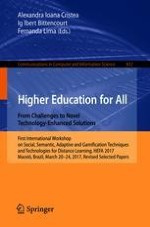2018 | Book
Higher Education for All. From Challenges to Novel Technology-Enhanced Solutions
First International Workshop on Social, Semantic, Adaptive and Gamification Techniques and Technologies for Distance Learning, HEFA 2017, Maceió, Brazil, March 20–24, 2017, Revised Selected Papers
Editors: Alexandra Ioana Cristea, Ig Ibert Bittencourt, Prof. Dr. Fernanda Lima
Publisher: Springer International Publishing
Book Series : Communications in Computer and Information Science
